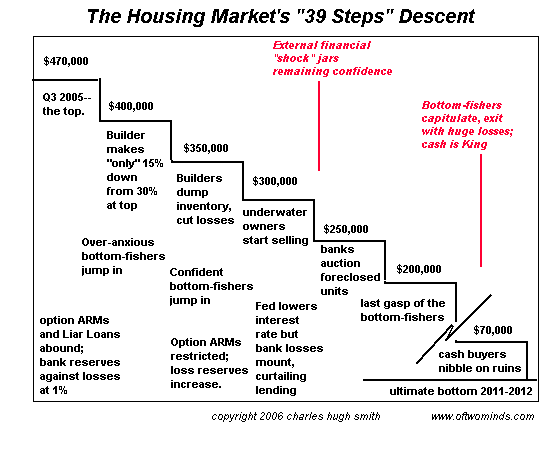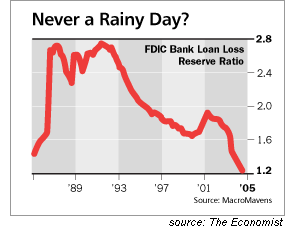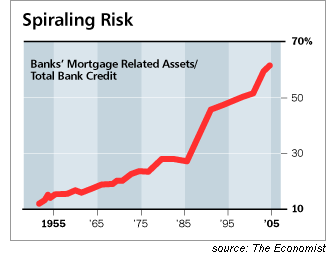

|
| weblog/wEssays archives | home | |
|
Housing's Stairstep Descent: the "39 Steps" (October 30, 2006) Last time we looked at housing's "Plateau of Denial"; today we look at the "39 steps" of its protracted, painful stairstep descent. I am, of course, referring to Alfred Hitchcock's delightful 1935 suspense/romance/espionage film classic, The 39 Steps Sounds like an excellent description of the real estate market. The market might well end up tracing far fewer than 39 such stairsteps down to its ultimate low in 2011 or 2012, but in the spirit of innocents plunged into financially deadly troubles and smooth sharpies playing hidden hands to the detriment of said innocents, here is an informal chart of the steps the housing market has already begun descending: 
Lest you imagine that I have made up the first stair down, please read Auctions' appeal grows with builders' inventory (Oct. 27, 2006) in the Los Angeles Times: For developers, getting saddled with unsold units drags down the bottom line. So selling off a slew of units at once makes sense, even if it cuts profit margins in the short term.Alas, over-anxious 24 year-olds are being suckered into paying a mere 15% profit to the condo developers rather than the 30% profits they commanded a year ago at the peak. For 24 year-olds, of course, memory holds nothing but a roaring housing boom; sadly, the idea of a 40% decline in valuations simply does not register as a possibility. Thus is Step 1 defined: over-anxious bottom-fishers jump in at the first hint of decline, confident that the roaring boom will soon re-appear. They have more chance of catching "The Great Pumpkin" on October 31. (with a tip of the hat to the "Peanuts" comic strip.) The next steps are already visible: a tightening of lending standards which will ultimately choke off the easy lending which fueled the boom. The answer, we're assured, is that the Fed will lower interest rates, re-igniting the blood lust for real estate. But Japan offers an interesting object lesson in this regard. Low interest rates do not necessarily translate into new loans being made. At the height of Japan's property bubble, when downtown Tokyo was worth more than all the real estate in the entire U.S., banks were literally begging customers to borrow another couple million dollars--for any purpose. After the bubble popped, Japan's central bank lowered interest rates to effectively zero, where they remain today, 15 years (and many tears) later--but the recovery in real estate in tepid and confined to central Tokyo. 
Why? Because banks were no longer able to lend money to poor risks, regardless of the low interest rate. As banks get stuck with non-performing loans, their losses mount, meaning that they have to raise cash to maintain even a mere 2% cash reserve against losses. (The current requirement for U.S. lenders is a paltry 1%--a number which is sure to rise.) As losses spiral out of control, their need for cash spirals up in tandem. The more foreclosed real estate they auction off to raise cash, the more they lose on their books as the foreclosed properties are sold for less than the mortgages. Japanese banks tried to cover up the fiasco by granting new loans so the bankrupt borrowers could make "interest payments" with freshly borrowed funds. But this legerdemain just increased their future losses, as the bankrupt borrower paid no actual interest on either the new or existing loans. 
We are already hearing of the same sort of obfuscatory practises being played in the U.S. as lenders desperate to keep non-performing loans off their books extend new credit to risky/bankrupt borrowers. When this house of credit cards collapses, as it surely will, the losses to lenders will preclude any future lending, no matter how low the Fed sets rates. And as I never tire of reminding readers, the Fed does not set long-bond or mortgage rates--the market does. And as risk rears its ugly head in the mortgage market, buyers of housing mortgages will begin demanding a risk premium--otherwise known as higher rates. This is why the stairstep leads down regardless of Fed policy or pronouncements. The train has already left the station, folks, and the Fed can wave its "magic interest rate wand" all it wants, but the train isn't coming back. For more on this subject and a wide array of other topics, please visit my weblog. copyright © 2006 Charles Hugh Smith. All rights reserved in all media. I would be honored if you linked this wEssay to your site, or printed a copy for your own use. |
||
| weblog/wEssays | home |